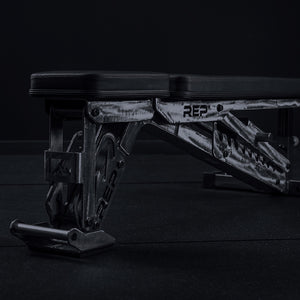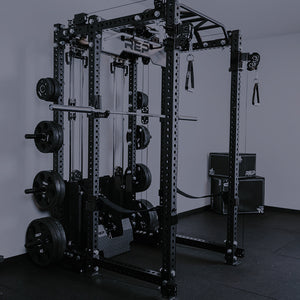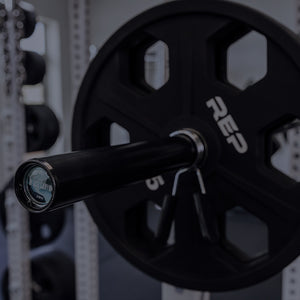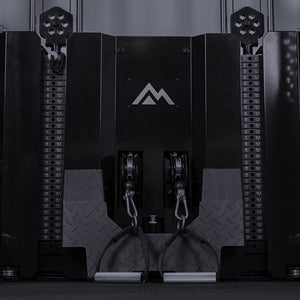
Squats are often called the king of all exercises. It’s hard to find a lifting program without them.
Movement and wellness coach and former competitive powerlifter Katie Kollath believes everyone needs to know how to squat, but which variation of squatting is most optimal and beneficial is truly dependent on the person.

Heather Hamilton (left) and Katie Kollath (right), of Barpath Fitness. Courtesy photo
Kollath is the co-owner and coach for Barpath Fitness, and she runs the podcast “Stronger Than Your Boyfriend.” She also has a master’s degree in exercise science. Most of her in-person clients don't do barbell back squats. “They’re older, and that’s not what they need, so we focus on different squat variations," Kollath says.
Here’s a look at 18 different kinds of squats and why they may be beneficial to add into your workout – as barbell back squat alternatives. Whether you're looking for a replacement or interested in adding in some substitutions to help you build a strong back squat.
1. LOW BAR/HIGH BAR

For starters, there are several different ways to do a barbell back squat. If one position isn’t feeling comfortable, try one of the others and see if that helps.
Low Bar
Low bar squats are common in the powerlifting community. Lifters are typically stronger with the bar resting on their traps, rather than on top of their traps. This bar position allows for more of a hip hinge, which engages more of the posterior chain.
Low bar may also have more of a forward lean, depending on the person. In that, it can be more comfortable for lifters with long femurs or tight ankles and hips.

High Bar
High bar squats place the bar on top of the traps, so your chest typically remains more upright. (The torso angle depends on the lifter’s unique proportions, though.) This can tap into your quads a little more, and high bar demands more hip and ankle mobility. Kollath likes to use this for lifters who aren’t competing in powerlifting.
“The key for both is making sure, for the most part, the barbell is staying over your mid-foot,” Kollath says.
Need help picking the right barbell for your squats? Here's a helpful guide.
2. BOX SQUATS
A box squat is typically done with a barbell or safety squat bar. It’s exactly how it sounds: Slowly control your descent until you sit all the way down onto a box, without losing your tightness. Keep your core tight as you stand up, while thinking about driving through your heels as hard as possible and exploding off the box.

Box squats can feel harder than back squats, due to that stop at the bottom of the squat. It removes that stretch reflex/momentum that can help you rebound upward. As such, box squats can be beneficial cross-training for lifters whose sticking point is getting out of the hole. It trains your explosive power on the concentric (upward) part of the lift.
You can also do box squats unloaded. A bodyweight box squat can help people who haven’t done much strength training. This can help train the squat movement pattern at a reduced range of motion, with the goal of building up to a full range of motion.
In addition to box squats, here are some more reasons to add a plyo box to your home gym.
3. TEMPO/PAUSE SQUATS

Tempo and pause squats can be performed with a barbell, other weight, or just bodyweight. Tempo squats require a different pace than a regular squat.
Kollath says she thinks most people squat too fast, so she likes to use a slower, three- to four-second descent, followed by a quick ascent.
Similarly, pause squats add a pause at the bottom of the squat to increase time under tension.
4. FRONT SQUATS
With a barbell front squat, you hold the barbell on the front side of the body, resting on the shoulders. These require a more upright position, which means more trunk and quad engagement. You also need to use your upper back to hold the bar in place for proper front barbell squat form.

“This is my favorite full-body movement,” Kollath says. “If I had to pick just one movement to do for the rest of my life, it’d be front squats. They get your core, upper body, and lower body all at once.”
A common mistake Kollath sees is people crossing their arms in front of their body to help prop up the barbell. “This is unstable and dangerous, because you can’t engage your upper back,” she says.
If your shoulders or wrists aren’t mobile enough, wrap a towel or straps around the bar, so you can lift your elbows higher. Ultimately, the way to improve your mobility is to do it more, she says. Just keep going.
5. ZERCHER SQUATS

You hold the bar in your elbow with Zercher squats. These can be beneficial for lifters coming off a back injury who don’t want a lot of hinging and want to assure an upright torso, but front squats aren't happening.
Zercher squats provide a similar stimulus as front squats, but with less demand on the upper back. Kollath loves them.
The issue? Many people hate Zerchers because they can be super uncomfortable or painful on the forearms and elbows. Therefore, you can’t load as much weight on a Zercher as a back squat.
6. SSB SQUATS

A lot of powerlifters use a Safety Squat Bar to cross-train the back squat. To keep the SSB in place, you must keep your torso more upright, so in that, it can be a sub for a front squat; you can’t let your chest dump forward with these suckers. You have to drive straight up into the pads, which loads the traps, upper back, and core while helping to train your hips from shooting up first.
Another benefit of a SSB is it’s a squat that takes the pressure off your elbows, wrists, and shoulders. So you can keep squatting even with elbow tendinitis or a shoulder injury. Or it helps save your upper body strength for the bench press.
Learn more: Why you should add a safety squat bar to your home gym.
7. OVERHEAD SQUATS

An overhead squat is a huge part of the snatch and Olympic weightlifting. This squat type requires an upright torso and will tax your shoulders. Kollath uses it as a shoulder mobility and stability drill. If you don’t have the ankle mobility to do an overhead squat, practice with heels elevated, either in heeled lifting shoes or with heels elevated on plates.
“You need as upright of a torso as possible; even the slightest lean forward and you’re really at risk to dump the barbell,” Kollath says.
Start with a PVC pipe to fine-tune the form. Then work up to a light, unloaded bar, like the 15lb Technique Barbell. Take it slow as you add weight and progress to a standard-size barbell.
8. LANDMINE SQUATS
The Landmine Attachment can be used in a ton of ways, including for landmine squats.
Slide the bar into the attachment sleeve (or prop the bar in a corner if you don’t have a proper landmine attachment) and rest the bar on your shoulders, facing away from it. Or flip around and hold the bar in a goblet position, so it’s front-loaded.

Either way, you’ll sit your hips back more with this squat, so it may feel extra spicy in your glutes and hammies.
This is a great variation if you have a shoulder or wrist injury, because you can still squat without having to hold the bar. Landmine squats can help people get comfortable training the full range of motion, because the bar provides a counterbalance. It’s easier to coordinate the movement and you don’t risk spilling the bar. Plus, you can load it a little heavier than a dumbbell squat.
In addition to landmine squats, here are different ways to use a landmine.
9. CYCLIST SQUATS
The goal of cyclist squats is to work the quads as much as possible. Ideally, perform them on a slanted board, but you can also use a bumper plate angled on a dumbbell – almost like doing squats in high heels. The heel elevation helps with ankle mobility.
The initiation of a cyclist squat is different than a regular squat, in that there’s no hinge. You initiate by pushing your knees forward while keeping your torso as upright as possible.
Think: squatting up and down against a wall. Start these with bodyweight only to get the movement down. Then progress to holding a dumbbell, goblet-style. The next step is to try these in the front rack position. The final progression is a barbell on your back.
10. "SISSY" SQUATS OR KNEES-OVER-TOES SQUATS
These are a higher-skill, quad-murderous movement that requires a lot of foot strength and stability, because you’re on the balls of your feet the entire time.
To properly do this squat, start with a calf raise. Try to keep the hips in a straight line from shoulders to knees the entire time. Lower down so the knees go past the toes, try to tap the floor with your knees, and raise back up without letting the hips shoot back.
Start by just doing eccentrics (downward) while lightly holding a rack for balance. Then remove the hand. Now add some concentric movement by tapping your knees to a box – not all the way to the floor, for a reduced range of motion. Eventually, you will work up to the full movement.
Un-fun fact: The sissy squat equipment you see at many gyms isn’t a true sissy squat because it holds your knees from going over your toes, Kollath says.
11. GOBLET SQUATS

Hold a dumbbell at your chest and squat. Simple. Goblet squats are great for people new to resistance training, because these squats require minimal skill compared with a barbell. They’re front-loaded, which helps counterbalance and keep your torso upright. With goblets, you can sink deeper, like a front squat, but it has a little more of a forward lean because the dumbbell rests lower than the bar.
Switch it up with a kettlebell held between your legs or at your chest. However, it may be a little easier to hold a dumbbell, because you can let it rest in your palms. You can also do goblet squats with a sandbag or medicine ball.
Learn more: Here are some more ways to use a dumbbell for a lower-body workout.
12. HACK SQUATS
You can do hack squats with a machine, barbell, or dumbbell. With free weights, hold the barbell behind your legs – resting on your hamstrings or with the bar floating behind you. If ankle mobility is an issue, elevate your heels like with the cyclist squat.
“I’m not a big fan of machines,” Kollath says. “I’d much rather have someone do a free-weight movement, where all the challenge comes from them manipulating their body in space, versus a fixed machine. Machines are great for recovering from an injury or bodybuilding if you need to do 20 million sets, but I would prefer to do a hack squat with free weights.”
13. BULGARIAN SPLIT SQUATS

Why squat with two legs when you can make it so much worse and squat with just one?
Bulgarian split squats are brutal but effective. With dumbbells by your sides, a barbell on your back, or with just your own bodyweight, elevate one foot on a bench or box. Squat down, putting as much weight in that front leg as possible, using the elevated leg for balance.
Play around with the height for different stimuli; the higher the elevation, the more stretch you’ll feel in the back leg quad, Kollath says. Also experiment with how far out the front foot is; closer to the bench will require the knee to go more over the toe = more quad. Farther out may hit the glutes harder, because the knee stays behind the toe. Torso angle will change based on where your foot is.
Bonus: A BSS also provides a decent stretch for the back hip and quad, so this can double up as a mobility drill for tight lifters.
14. PISTOL SQUATS
These are another single-leg squat variation – a higher-skilled movement. Instead of squatting with a leg behind you, like in Bulgarian split squats, you squat with one leg in front of you. Many people think they don’t have the mobility to do these, but if you can do a bodyweight squat, you can do a pistol squat, Kollath says.
"You must lift that [non-squatting] leg up high enough to not hit the floor, so many people don’t have the strength in the hip flexor to lift the foot up,” she says.
That’s the hardest part. But it can be trained.
Start pistol squats while standing on a box, with the non-squatting leg hanging off the side. Also practice isometric holds – holding the bottom position with the non-squatting leg held up as long as possible to build strength in the hip flexors. Hold onto a rack if you need help with balance and progress to just the eccentric (lowering) movement. Over time, you’ll get the full shebang.
15. JUMP SQUATS

Jump squats train explosive power. Kollath does them at the beginning of the workout right after warm-ups. Instead of doing 50 jump squats in a row, she recommends doing sets of two to three with a 30- or 60-second rest between reps. You want your jump squats as fresh as possible. Jump. Explode. Rest. Repeat.
"Most people who want to do a jump squat are trying to gain explosive power in those fast twitch muscle fibers. Doing 50 in a row is endurance. Instead, do one rep at a time as fast as you can,” she says.
You can do jump squats on the floor or on a box.
Learn more: How to improve box jumps (and overcome the fear).
16. COSSACK SQUATS
Think of these as a lateral lunge squat, where you start with your feet wide, keep upright, and lunge to the side. The goal is to eventually get as deep as you can, while keeping torso upright.
Keep the extended leg’s foot facing forward and flat on the ground. When the adductor mobility runs out, you can add range of motion by twisting on that heel and lifting its toes toward the ceiling. A Cossack squat is great for hip and adductor strength and mobility.
17. SHRIMP SQUATS
These are another good way to destroy the quads – and another higher-skilled movement that really maxes out the concept of “knees over toes.” Shrimp squats are like knees-over-toes/sissy squats, except harder because they’re on one leg.
18. BELT SQUATS

Belt squats allow you to add volume and variation to your squat training and train around upper body injuries or limitations (shoulder, back, elbow, wrist). Simply attach the Belt Squat Attachment to your power rack, slip into the belt, and squat without getting your upper body too involved.
Belt squats allow for strength training with minimal tension on your spine. They offer a greater challenge than traditional squatting, due to the constant resistance.
To achieve proper depth, make sure that you have the correct length belt and the chain set up correctly. If your belt is too long, you can set up plates or a platform to obtain the right height for more effective movement. Use a Cable Catch Attachment to allow you to start from the top of your squat. Starting from the bottom is not difficult when lifting sub-maximal weight, so this attachment comes in handy when you are pushing your limits.
Learn more: Creative ways to use a dip belt with a Belt Squat Attachment.
Takeaway
Whether you're recovering from an injury, have limited mobility, or you just don't like doing barbell back squats, we've got a variation to help you continue to tackle squats.
Pick a back squat substitute that sparks your interest, dial in the form without using weight, then work with progressive overload to build strength and muscle.
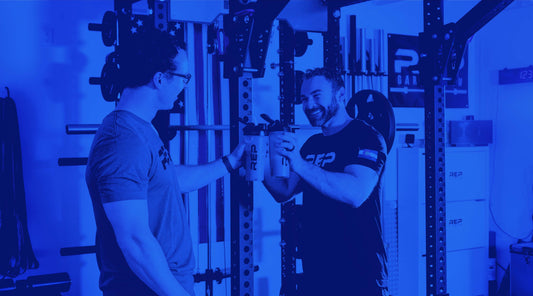
NEWSLETTER SIGNUP
Product launch information, promotions, blogs, and REP news.

